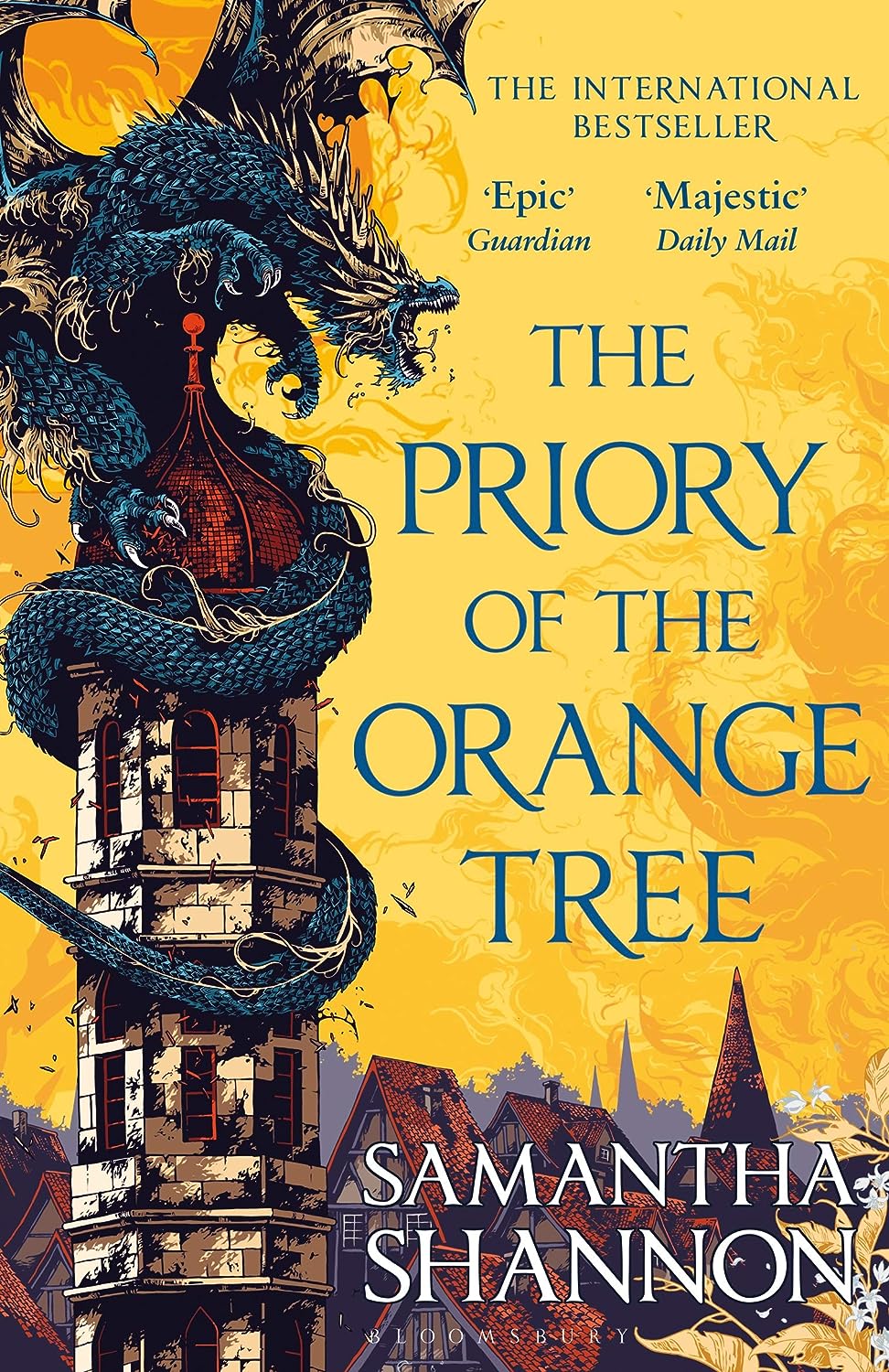
The Priory of the Orange Tree
Forty-Eight
by Shannon, SamanthaThe chapter opens on Feather Island, where the aftermath of a fire is being quenched by heavy rain. The Little Shadow-girl emerges from exile and connects with the earth, reflecting on the celestial origins of a powerful jewel she carries. This jewel, a remnant of a comet that ended the Great Sorrow, is revealed to be one of two ancient artifacts imbued with cosmic power. The narrative hints at their historical significance, suggesting they once granted control over natural forces to their bearers.
The jewel, now cleansed by the rain, symbolizes both a deep connection to the past and a burden of responsibility. The girl contemplates its history, noting how these celestial fragments were lost for nearly a millennium but never truly forgotten. Her internal monologue reveals the jewel’s importance to her people’s strength and survival, framing it as a key to reclaiming lost power. The dark blue hue of the jewel mirrors the depths of the Abyss and her own heart, emphasizing its profound emotional and mystical weight.
In a moment of resolve, the girl—revealed to be Tané—makes a solemn vow amidst the storm. She pledges to reunite the jewel with Nayimathun, a dragon currently held in captivity. This promise is portrayed as a sacred commitment, echoing ancient covenants made before the gods. Tané’s determination is unwavering, even if the quest spans her entire lifetime, underscoring the depth of her loyalty and the gravity of her mission.
The chapter concludes with Tané’s unwavering dedication to her vow, highlighting themes of redemption, sacrifice, and the enduring bond between beings and their heritage. The storm’s eye serves as a metaphorical and literal crossroads, where past and future converge. Tané’s journey is set in motion, promising a pursuit that will test her resolve and redefine her destiny. The jewel, now a beacon of hope, becomes the focal point of her quest to restore what was stolen and mend the fractures of history.
FAQs
1. What is the significance of the celestial jewels mentioned in the chapter, and how are they connected to the comet?
Answer:
The celestial jewels are solid fragments left behind by a comet that ended the Great Sorrow. According to the chapter, these jewels are infused with the comet’s power and were once used by ancestors to control the waves and retain their strength. The Little Shadow-girl possesses one of these jewels, which she has protected and nurtured within her body. Their loss for nearly a thousand years suggests their immense importance, and their rediscovery could hold the key to restoring power or fulfilling ancient promises, as hinted by Tané’s vow.2. Analyze Tané’s vow at the end of the chapter. What does it reveal about her character and her relationship with Nayimathun?
Answer:
Tané’s vow to find Nayimathun and reunite the dragon with the stolen jewel demonstrates her deep sense of loyalty and determination. Despite the potential lifetime it may take, she commits to this mission, highlighting her resilience and devotion. Her relationship with Nayimathun appears to be one of profound respect and possibly kinship, as she seeks to restore what was taken from the dragon. This act also suggests a theme of redemption or justice, as Tané aims to rectify a past wrong, emphasizing her moral compass and emotional connection to Nayimathun.3. How does the setting of Feather Island contribute to the mood and themes of the chapter?
Answer:
The rain-quenched, burned trees of Feather Island create a somber and reflective mood, symbolizing both destruction and renewal. The island’s desolation mirrors the Little Shadow-girl’s exile and the broader loss of the celestial jewels. However, the rain cleansing the jewel and Tané’s vow introduce a sense of hope and purpose. The setting underscores themes of resilience and rebirth, as the characters navigate a world marked by past sorrows but with the potential for healing. The storm’s eye, where promises are sealed, further emphasizes moments of clarity and commitment amid chaos.4. What might the “unbreakable promises sealed before the gods” imply about the world’s history and the role of vows in this narrative?
Answer:
The reference to “unbreakable promises sealed before the gods” suggests a world where oaths and covenants hold significant, possibly supernatural, weight. This implies a deep cultural or spiritual tradition where vows are binding and tied to divine forces. Historically, such promises may have shaped pivotal events, like the control of the waves with the jewels. Tané’s vow in the same sacred space aligns her with this tradition, indicating that her commitment could have far-reaching consequences. It also hints at a recurring theme of fate, duty, and the interplay between mortal actions and higher powers.
Quotes
1. “The comet ended the Great Sorrow, but it has come to this world many times before. Once, many moons ago, it left behind two celestial jewels, each infused with its power. Solid fragments of itself.”
This quote introduces the mythic backstory of the celestial jewels, establishing their cosmic origin and significance. It frames the chapter’s central object (the jewel) within the larger lore of the world.
2. “With them, our ancestors could control the waves. Their presence allowed us to hold on to our strength for longer than we could before.”
This reveals the jewels’ historical importance and magical properties, explaining why they’re worth protecting and seeking. It connects the physical object to cultural memory and power.
3. “Not lost. Hidden.”
This terse statement marks a key turning point in the narrative, shifting from mythological backstory to present action. The distinction between “lost” and “hidden” suggests deliberate concealment and potential recovery.
4. “That even if it took her until her dying day, she would find Nayimathun, free her from captivity, and make a gift of this jewel.”
This vow represents the chapter’s emotional climax and establishes Tané’s driving purpose. The promise ties together the jewel’s significance with personal redemption and loyalty to Nayimathun.
